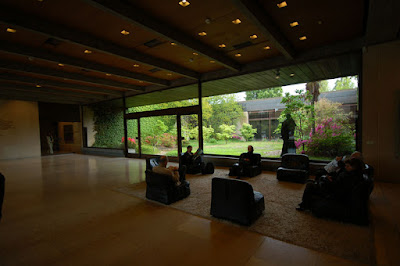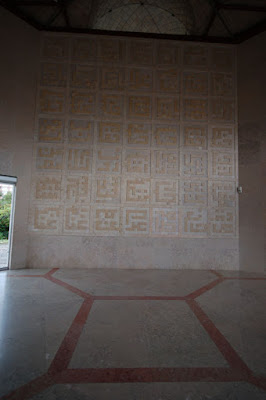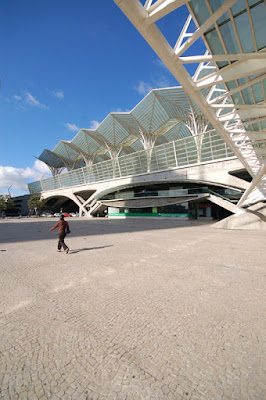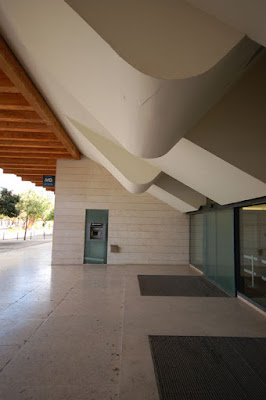There is a great sense of responsibility of the architect to maintain a certain dialogue with the existing buildings and it results in a building that is at the same time very modern but with a lot of local inspirations and elements. The main façades are covered with stone Lioz and the blue tiles, traditional of Portugal.
.jpg)
And here’s one more project in the heart of Lisbon designed by Siza. The Baixa-Chiado Metro station links the blue as well as the green line of the Metro system in Lisbon and is one of the most important transfer stations.


Next series of photos are of the two museums run by the Calouste Gulbenkian foundation and its beautiful gardens.  The Gulbenkian Museum in my opinion is one of the great museums in Europe, and houses a magnificent collection of Egyptian, Greek, Roman, Islamic, Asian, and European art.
The Gulbenkian Museum in my opinion is one of the great museums in Europe, and houses a magnificent collection of Egyptian, Greek, Roman, Islamic, Asian, and European art.
 The Gulbenkian Museum in my opinion is one of the great museums in Europe, and houses a magnificent collection of Egyptian, Greek, Roman, Islamic, Asian, and European art.
The Gulbenkian Museum in my opinion is one of the great museums in Europe, and houses a magnificent collection of Egyptian, Greek, Roman, Islamic, Asian, and European art..jpg)
.jpg)
But is not just the collection here that is great - the architecture of the museum is equally good!
.jpg)
.jpg) The Modern Art Center (photo below), containing modern and contemporary Portuguese art is housed with the same grounds.
The Modern Art Center (photo below), containing modern and contemporary Portuguese art is housed with the same grounds.
.jpg) And if those two museums weren't good enough, wait till you check out the lovely serene gardens!
And if those two museums weren't good enough, wait till you check out the lovely serene gardens!.jpg) I was told that this is 'the best modern garden in Portugal'; I haven't seen much of Portugal but I can say this - it is highly unlikely that there would be one better than this.
I was told that this is 'the best modern garden in Portugal'; I haven't seen much of Portugal but I can say this - it is highly unlikely that there would be one better than this.  This is the rectory of Universidade Nova de Lisboa
This is the rectory of Universidade Nova de Lisboa
.jpg)
.jpg) Next is a project by Indian architect - Raj Rewal
Next is a project by Indian architect - Raj Rewal
 This the Ismaili centre in Lisbon is probably the most significant building designed by an Indian architect in Europe.
This the Ismaili centre in Lisbon is probably the most significant building designed by an Indian architect in Europe.
.jpg)
.jpg) It houses some cultural/religious facilities for the Aga Khan community and relies a lot on borrowing from an Islamic tradition of art/architecture & landscape.
It houses some cultural/religious facilities for the Aga Khan community and relies a lot on borrowing from an Islamic tradition of art/architecture & landscape.
.jpg)
.jpg) Next - The Cultural Centre of Belém (CCB), located in the Belém quarter of Lisbon,
Next - The Cultural Centre of Belém (CCB), located in the Belém quarter of Lisbon, 
.jpg)
.jpg) is the largest building with cultural facilities in Portugal and is the work of architects Vittorio Gregotti and Manuel Salgado.
is the largest building with cultural facilities in Portugal and is the work of architects Vittorio Gregotti and Manuel Salgado.
.jpg)
.jpg) The Modern Art Center (photo below), containing modern and contemporary Portuguese art is housed with the same grounds.
The Modern Art Center (photo below), containing modern and contemporary Portuguese art is housed with the same grounds..jpg) And if those two museums weren't good enough, wait till you check out the lovely serene gardens!
And if those two museums weren't good enough, wait till you check out the lovely serene gardens!.jpg) I was told that this is 'the best modern garden in Portugal'; I haven't seen much of Portugal but I can say this - it is highly unlikely that there would be one better than this.
I was told that this is 'the best modern garden in Portugal'; I haven't seen much of Portugal but I can say this - it is highly unlikely that there would be one better than this. While visiting Lisbon even if you ran out of time to see these museums - DON'T miss this garden!
Next is a much celebrated project by the upcoming Portuguese architects – Aires Mateus
 This is the rectory of Universidade Nova de Lisboa
This is the rectory of Universidade Nova de Lisboa.jpg)
.jpg) Next is a project by Indian architect - Raj Rewal
Next is a project by Indian architect - Raj Rewal This the Ismaili centre in Lisbon is probably the most significant building designed by an Indian architect in Europe.
This the Ismaili centre in Lisbon is probably the most significant building designed by an Indian architect in Europe..jpg)
.jpg) It houses some cultural/religious facilities for the Aga Khan community and relies a lot on borrowing from an Islamic tradition of art/architecture & landscape.
It houses some cultural/religious facilities for the Aga Khan community and relies a lot on borrowing from an Islamic tradition of art/architecture & landscape..jpg)
.jpg) Next - The Cultural Centre of Belém (CCB), located in the Belém quarter of Lisbon,
Next - The Cultural Centre of Belém (CCB), located in the Belém quarter of Lisbon, 
.jpg)
.jpg) is the largest building with cultural facilities in Portugal and is the work of architects Vittorio Gregotti and Manuel Salgado.
is the largest building with cultural facilities in Portugal and is the work of architects Vittorio Gregotti and Manuel Salgado.Starting with the geometric marvel of the Oriente station by Santiago Calatrava

.jpg)
.jpg)
.jpg)
.jpg)
.jpg) Below is a view from the cable car above the park - in the distance the white mast shaped building is the Vasco da Gama tower (Lisbon's tallest building) and to the right the Vasco da Gama bridge (Europe's longest at 17kms)
Below is a view from the cable car above the park - in the distance the white mast shaped building is the Vasco da Gama tower (Lisbon's tallest building) and to the right the Vasco da Gama bridge (Europe's longest at 17kms)  Next is the pavilion that was the centrepiece of the Expo’98 – the Portuguese Pavilion designed by none other than Alvaro Siza.
Next is the pavilion that was the centrepiece of the Expo’98 – the Portuguese Pavilion designed by none other than Alvaro Siza.
 This is probably his most recognized masterpiece, both for the tension he manages to create between a necessary, desired and difficult monumentality, and the delicate articulation - with the program and the location - both for daring of the solution and its intensive effect of a representative image symbol.
This is probably his most recognized masterpiece, both for the tension he manages to create between a necessary, desired and difficult monumentality, and the delicate articulation - with the program and the location - both for daring of the solution and its intensive effect of a representative image symbol.
.jpg)
.jpg)
.jpg)
.jpg)
.jpg) And the last project is this entry is The Pavilion of Knowledge – another masterpiece of architecture – designed by João Luís Carrilho da Graça .
And the last project is this entry is The Pavilion of Knowledge – another masterpiece of architecture – designed by João Luís Carrilho da Graça .

.jpg)
.jpg) The access patio is square. It rises up to the entrance by a ramp which accompanies the periphery of the square.
The access patio is square. It rises up to the entrance by a ramp which accompanies the periphery of the square. .jpg)
.jpg)

.jpg)
.jpg)
.jpg)
.jpg)
.jpg) Below is a view from the cable car above the park - in the distance the white mast shaped building is the Vasco da Gama tower (Lisbon's tallest building) and to the right the Vasco da Gama bridge (Europe's longest at 17kms)
Below is a view from the cable car above the park - in the distance the white mast shaped building is the Vasco da Gama tower (Lisbon's tallest building) and to the right the Vasco da Gama bridge (Europe's longest at 17kms)  Next is the pavilion that was the centrepiece of the Expo’98 – the Portuguese Pavilion designed by none other than Alvaro Siza.
Next is the pavilion that was the centrepiece of the Expo’98 – the Portuguese Pavilion designed by none other than Alvaro Siza. This is probably his most recognized masterpiece, both for the tension he manages to create between a necessary, desired and difficult monumentality, and the delicate articulation - with the program and the location - both for daring of the solution and its intensive effect of a representative image symbol.
This is probably his most recognized masterpiece, both for the tension he manages to create between a necessary, desired and difficult monumentality, and the delicate articulation - with the program and the location - both for daring of the solution and its intensive effect of a representative image symbol..jpg)
.jpg)
.jpg)
.jpg)
.jpg) And the last project is this entry is The Pavilion of Knowledge – another masterpiece of architecture – designed by João Luís Carrilho da Graça .
And the last project is this entry is The Pavilion of Knowledge – another masterpiece of architecture – designed by João Luís Carrilho da Graça .
Here the horizontal block of the pavilion is virtually suspended allowing the continuity of the public area between the broad walk and the dock.
.jpg)
.jpg) The access patio is square. It rises up to the entrance by a ramp which accompanies the periphery of the square.
The access patio is square. It rises up to the entrance by a ramp which accompanies the periphery of the square. .jpg)
.jpg)

.jpg)
.jpg)
.jpg)
.jpg)
.jpg)
No comments:
Post a Comment